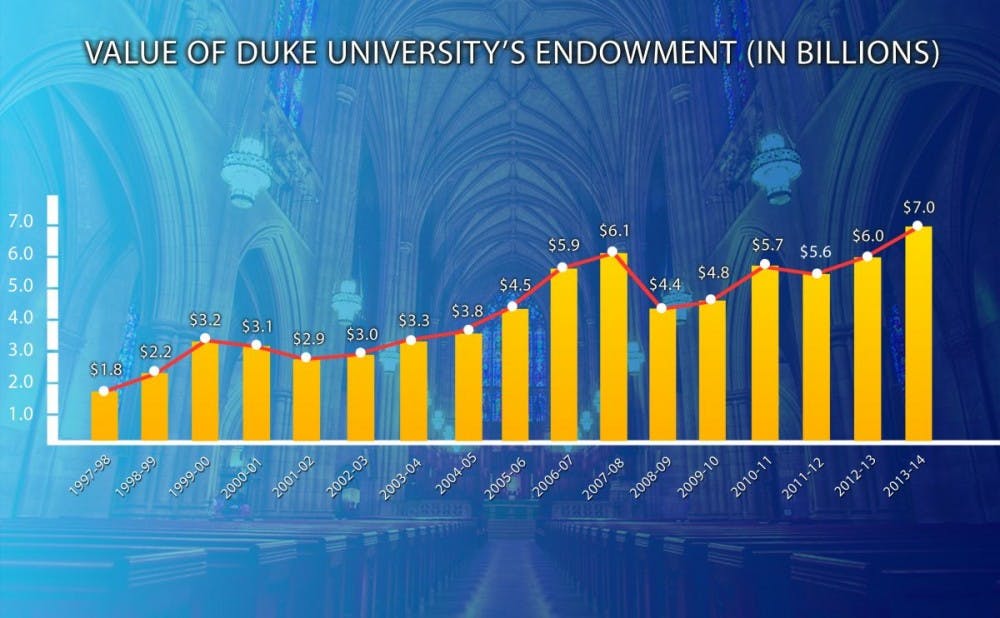Following congressional questions about how the University spends its $7.3 billion endowment, Duke administrators recently issued a response outlining their financial decisions.
The University’s 13-page response followed a Feb. 8 letter written by Orrin Hatch, chairman of the Senate Committee on Finance, Kevin Brady, chairman of the House Ways and Means committee and Peter Roskam, chairman of the House Ways and Means Oversight subcommittee, which was sent to 56 private universities with endowments of more than $1 billion. As university endowments have grown in recent years, Congress is examining federal policies that allow tax-free investment earnings for schools and tax deductions for donors.
One congressional proposal suggests that with the cost of college continuing to increase, universities should spend more on tuition relief.
“Despite these large and growing endowments, many colleges and universities have raised tuition far in excess of inflation,” the Feb. 8 letter reads.
Duke’s response to the inquiry—which was sent March 29 with a two-page cover letter signed by President Richard Brodhead—is intended to clarify misconceptions about the purpose of endowments, said Michael Schoenfeld, vice president for public affairs and government relations.
“At this point, given the legal, economic and financial constraints on an endowment, there isn’t a whole lot of leeway to change things and still maintain the kind of growth and security for the future that you’re enjoying today,” Schoenfeld said.
Duke, which had a $7.3 billion endowment in 2015 that ranked 16th among colleges nationwide, spent $307 million, or 4.9 percent of its total endowment, in fiscal year 2015. This rate is comparable to rates at Princeton University and Washington University in St. Louis, which reported spending distribution percentages of 4.2 percent and 4.0 percent, respectively.
“The real concern is if you spend more from your endowment, then less is available for your future,” Schoenfeld said. “So you are essentially short-changing the future in order to address some issue in the present. And we as a University take a very long-term view of things.”
In the years following the 2008 financial crisis, Duke’s endowment has grown considerably, from $4.4 billion in fiscal year 2009 to the present $7.3 billion figure.
“The affluent are making more gifts, the stock market has been on a tear and the rates of return for these endowments border on the unbelievable,” said Charles Clotfelter, Z. Smith Reynolds professor of public policy studies and professor of economics and law.
Clotfelter pointed out that while income has stagnated among the population outside the top 5 percent of wealth in the country, universities have benefited from the greater income inequality.
Various proposals have been suggested in Congress, including removing tax breaks for universities or requiring the universities to spend a certain percentage of their endowments each year. Schoenfeld said he thinks that these ideas are misguided.
“If you move it up to 10 or 15 percent, you would have to generate returns on the order of 20 percent every year in order to ensure that the endowment remains a permanent fund,” he said. “The endowment is not a retirement fund.”
Much like other universities, a large proportion of Duke’s endowment is tied to specific purposes as appropriated by individual donors. Duke’s response indicates that about $5.1 billion, or 69 percent, of the endowment is restricted by the terms of the donor’s gift to the University.
“You can only spend your endowment on what people designate you to spend it on,” Schoenfeld said. “If somebody is giving you endowment for a professorship or the upkeep of a collection in the library, you can’t just decide that you’re going to spend that on financial aid—that’s against the law.”
Congressional attention largely stems from concerns outlined in the letter about whether the universities, which benefit from tax-free investment earnings, are “using endowment assets to fulfill their charitable and educational purposes.”
“One of the things people might wonder is, ‘How can you pay a football or basketball coach so much money if you are a nonprofit organization?’” Clotfelter said.
In his cover letter, Brodhead sought to prove that students were being kept the priority through efforts such as financial aid.
“Duke’s commitment to access and affordability represents an investment of more than $130 million last year—triple the investment the University made 10 years ago,” he wrote.
In fiscal year 2015, 21.1 percent of the endowment was devoted to financial aid, with a small portion going directly to students in the current year. Duke conducts need-blind admissions and meets the full demonstrated financial need for every undergraduate student. Brodhead noted that during the 2008 financial crisis in which the value of the endowment dropped by 25 percent, the University’s funding for financial aid experienced no cutbacks.
The report marks the second time in eight years that Duke disclosed financial information to Congress after a 2008 Senate Finance Committee inquiry requested similar data on the endowment and financial aid spending.
Clotfelter noted that Congress has generally been hesitant to pass legislation related to the financial conduct of universities.
“I would say Congress in terms of finances of universities have been pretty hands off over time,” he said. “So I think if they did something like that it would be kind of unprecedented.”
Schoenfeld echoed a sentiment also made by several peer institutions that it is important not to misunderstand the reasoning behind how the endowment is spent.
“It is valuable and useful for policymakers to continue to have a better understanding and for us to educate them on the role of an endowment,” he said. “They have provided and help create a system of education, health care and culture that is pretty unrivaled around the world and it’s in part because of that financial foundation that looks to the future.”

